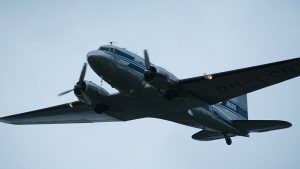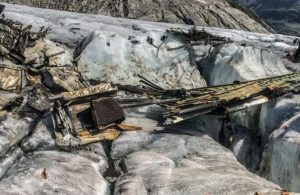 Storms and high winds are not unusual in the Swiss Alps, and flying over any mountain can find a flight crew in hot water. Over the Swiss Alps, on November 18, 1946, the crew of the C-53 Skytrooper with serial 42-68846 that had taken off from Tulln Air Base near Vienna, Austria, was bound for Pisa in Northern Italy, when they encountered problems. The flight took them over Innsbruck in the Western Austrian Alps. While flying over the Canton of Bern, Switzerland, the weather had unknowingly caused them to lose their bearings. Their actual flight path was taking them deeper South, into the Alps of Central Switzerland.
Storms and high winds are not unusual in the Swiss Alps, and flying over any mountain can find a flight crew in hot water. Over the Swiss Alps, on November 18, 1946, the crew of the C-53 Skytrooper with serial 42-68846 that had taken off from Tulln Air Base near Vienna, Austria, was bound for Pisa in Northern Italy, when they encountered problems. The flight took them over Innsbruck in the Western Austrian Alps. While flying over the Canton of Bern, Switzerland, the weather had unknowingly caused them to lose their bearings. Their actual flight path was taking them deeper South, into the Alps of Central Switzerland.
As often occurs in high mountains, the aircraft encountered a violent downdraft, known as a katabatic wind at a speed of 170 miles per hour. The katabatic wind is comparable to a microburst that basically pushes even big jets into the ground on approach flights. The downdraft caused the aircraft to lose height rapidly in poor visibility conditions. There was no time to recover, and at 2:45pm, the plane hit terrain and crash-landed into the Gauli Glacier at an altitude of 10,990 feet. They had gone down just about 8 miles south of the Swiss Air Force Base Meiringen.
The crash had the potential of being a deadly situation. Crashing a plane into terrain…especially at a high altitude is not usually survivable, but this was a God Gift. The crash occurred on snow-covered near-flat terrain with a slightly sloping hill. For the passengers and crew in the aircraft to step out alive…that was the God Gift. Very few people have crashed into terrain and lived tell the story afterwards! The crew was able to send a distress call from the stricken plane that was picked up in Paris and Lyon, but they erroneously presumed that the crash had occurred in the French Alps. Two days later, an officer based in the control tower of the Meiringen airbase, received a message on his frequency as well and gave the alert of a new radio bearing, narrowing the search area to the Gauli Glacier. That’s two days in freezing November nights at 10,990 feet, with only the fuselage to protect them from the elements. There were two sightings during breaks in the clouds, and finally a rescue team made their way up to bring the crew and passengers down. Twelve people survived the crash and lived to tell about it.
After the rescue, the plane sat there in the glacier until the summer of 1947, when the dismantling of the  aircraft started. The most precious parts like engines, and (cockpit) interior were airlifted from the scene. The bend propellers were left behind and the partially empty but intact airframe was left behind on the Glacier, where the ice would slowly grind it to pieces. In 2012, pieces of the C-53 began to appear as the glacier melted in the sunlight. Amazingly, there were no traces of corrosion. While the ice has made its mark on the plane’s structure, rendering it to a state that only remotely resembles the plane, it is still there. It now looks like the plane was torn apart in the crash. Of course, we know that was not the case at all.
aircraft started. The most precious parts like engines, and (cockpit) interior were airlifted from the scene. The bend propellers were left behind and the partially empty but intact airframe was left behind on the Glacier, where the ice would slowly grind it to pieces. In 2012, pieces of the C-53 began to appear as the glacier melted in the sunlight. Amazingly, there were no traces of corrosion. While the ice has made its mark on the plane’s structure, rendering it to a state that only remotely resembles the plane, it is still there. It now looks like the plane was torn apart in the crash. Of course, we know that was not the case at all.


2 Responses to In The Melting Glacier